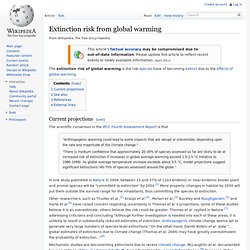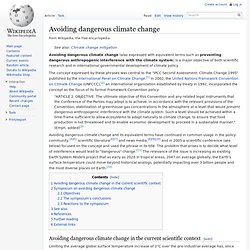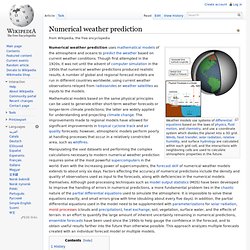

Extinction risk from global warming. The extinction risk of global warming is the risk species have of becoming extinct due to the effects of global warming.

Current projections[edit] The scientific consensus in the IPCC Fourth Assessment Report is that "Anthropogenic warming could lead to some impacts that are abrupt or irreversible, depending upon the rate and magnitude of the climate change. ""There is medium confidence that approximately 20-30% of species assessed so far are likely to be at increased risk of extinction if increases in global average warming exceed 1.5-2.5 °C (relative to 1980-1999). As global average temperature increase exceeds about 3.5 °C, model projections suggest significant extinctions (40-70% of species assessed) around the globe. " Other researchers, such as Thuiller et al.,[2] Araújo et al.[3] , Person et al.,[4] Buckley and Roughgarden,[5] and Harte et al.[6] have raised concern regarding uncertainty in Thomas et al.' See also[edit] References[edit] External links[edit] Avoiding dangerous climate change. Avoiding dangerous climate change (also expressed with equivalent terms such as preventing dangerous anthropogenic interference with the climate system) is a major objective of both scientific research and in international governmental development of climate policy.

The concept expressed by these phrases was central to the "IPCC Second Assessment: Climate Change 1995" published by the International Panel on Climate Change.[1] In 2002, the United Nations Framework Convention on Climate Change (UNFCCC),[2] an international organization established by treaty in 1992, incorporated the concept as the focus of its formal Framework Convention policy: "ARTICLE 2. OBJECTIVE. Avoiding dangerous climate change and its equivalent terms have continued in common usage in the policy community,[4][5] scientific literature[6][7] and news media,[8][9][10] and in 2005 a scientific conference (see below) focused on the concept and used the phrase in its title. Objectives[edit] [edit] Climate model. This article is about the theories and mathematics of climate modeling.

For computer-driven prediction of Earth's climate, see Global climate model. Climate models are systems of differential equations based on the basic laws of physics, fluid motion, and chemistry. To “run” a model, scientists divide the planet into a 3-dimensional grid, apply the basic equations, and evaluate the results. Atmospheric models calculate winds, heat transfer, radiation, relative humidity, and surface hydrology within each grid and evaluate interactions with neighboring points. Climate models use quantitative methods to simulate the interactions of the atmosphere, oceans, land surface, and ice.
All climate models take account of incoming energy from the sun as short wave electromagnetic radiation, chiefly visible and short-wave (near) infrared, as well as outgoing energy as long wave (far) infrared electromagnetic radiation from the earth. Models can range from relatively simple to quite complex: where. Numerical weather prediction. Numerical weather prediction uses mathematical models of the atmosphere and oceans to predict the weather based on current weather conditions.

Though first attempted in the 1920s, it was not until the advent of computer simulation in the 1950s that numerical weather predictions produced realistic results. A number of global and regional forecast models are run in different countries worldwide, using current weather observations relayed from radiosondes or weather satellites as inputs to the models. Mathematical models based on the same physical principles can be used to generate either short-term weather forecasts or longer-term climate predictions; the latter are widely applied for understanding and projecting climate change. The improvements made to regional models have allowed for significant improvements in tropical cyclone track and air quality forecasts; however, atmospheric models perform poorly at handling processes that occur in a relatively constricted area, such as wildfires.